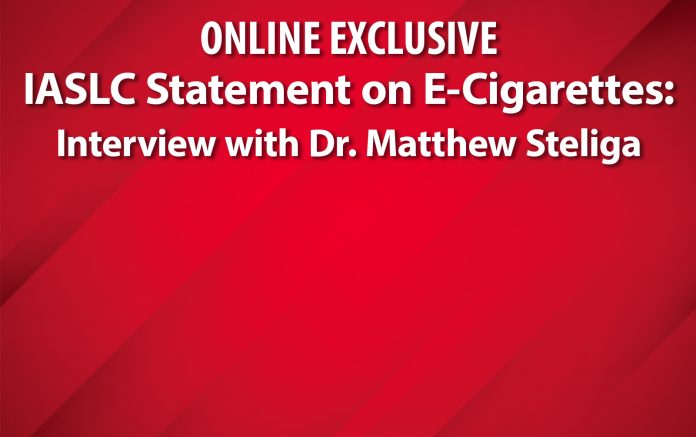Posted: November 12, 2019
Dr. Matthew Steliga, chair of the IASLC Tobacco Control and Smoking Cessation Committee and thoracic surgeon and head of the Tobacco Cessation Program at Winthrop P. Rockefeller Cancer Institute, met with IASLC Lung Cancer News (ILCN) to discuss the impetus for the statement, the role of electronic cigarettes in tobacco cessation, and why isolating a specific cause for the vaping-related illnesses seen in the United States has been so difficult. Dr. Steliga also provides commentary on the best practices to help patients quit smoking.
What was the main motivation for releasing the statement?
There have been a lot of cases both in the news and that we, as doctors, have seen in our clinical practice recently regarding illness related to use of electronic cigarettes, known as vaping. The original statement by the committee was issued a few years ago, but we wanted to update it due to the evolution of vaping technology. The committee wants to be current regarding the potential harms to patients from vaping and, if there are any benefits, what those benefits could be. There are a number of claims of benefits by the vaping industry and other groups, so assessment of benefit will be an ongoing task for the committee.
The statement aligns pretty closely with the 2018 American Cancer Society position statement on electronic cigarette use. Are there any additional insights you could offer ILCN readers regarding the information in the statement or on the importance of cessation in general?
We fully support [the American Cancer Society’s] statement, and the alignment of the statements means that we share the common goal of decreasing tobacco use.
Smoking cessation is the greatest controllable risk factor for lung cancer, one which has been shown to affect therapeutic outcomes. We cannot control age, genetic mutations, or some comorbidities, but tobacco use is something we can control and should strive to control. If we can eliminate tobacco use, we can decrease a person’s risk of developing lung cancer (including second primary/new cancers), cardiovascular disease, COPD, and emphysema. We also improve patients’ odds for better outcomes with certain treatments. People who are undergoing cancer treatments—whether it’s surgery, chemotherapy, or radiation— often have increased risk of harm during treatment from continued smoking. If we can decrease smoking, even after a diagnosis of lung cancer, there is still value to that.
In April 2019, there was a New England Journal of Medicine article published about using electronic cigarettes in the United Kingdom to help smokers quit combustible cigs. It turned out that electronic cigarettes were more effective than the nicotine-replacement therapy of the smoker’s choice, but 80% of those who quit smoking while using electronic cigarettes were still using electronic cigarettes at 1 year out. Are further trials regarding electronic cigarettes for cessation warranted?
In the trial setting, it was very structured, where people had either electronic cigarettes or nicotine-replacement therapy of choice, and they were also followed closely by physicians and had counseling. Counseling and a structured follow up are really quite important. If further trials with electronic cigarettes are undertaken, standardization of the devices and the composition of the liquid, as well as close safety monitoring, would be needed, especially in light of recent reports of vaping-related illnesses.
Unfortunately, in the real world, electronic cigarettes are not one type of device with one type of liquid in it. It’s a huge umbrella term, including many different types of devices from many different companies, and those liquids can vary quite a bit, particularly the liquid tank-style electronic cigarettes that contain liquid with added flavorings and other additives. I think you’re looking at something very different when you talk about structuring a trial; in this regard, physicians and clinicians usually think about a drug trial, but this is challenging when there is widespread use of a diverse array y of heterogeneous devices with heterogeneous contents.
Electronic cigarettes and vaping are in the news on almost a daily basis because of related illnesses and deaths. Knowing that more information is forthcoming from regulatory and government agencies, please explain how some of these illnesses could be manifesting.
The harms that we’ve seen, to my knowledge, have occurred predominantly in the United States, which implicates certain liquids, additives, or devices that may be used in the United States but not elsewhere. In addition, certain vaping-related illnesses or problems are being observed more frequently where the incidence of electronic cigarette use is much higher. In areas of the United States, teen and youth vaping rates are at an all-time high. Perhaps there is a connection between the rates of electronic cigarette use in the US population and the incidence of disease.
I think it is very important to note that, while severe illnesses that have resulted in death and hospitalization have been widely publicized, there may be many more, less-serious but still significant illnesses or damage to the lungs being caused by vaping. This could be happening in high numbers, but we are unaware simply because symptoms are confused with those of other conditions or illnesses, or not identified in their early stages.
Since there are so many different types of devices and types of liquid that are heated and aerosolized, it is hard to know exactly what is causing vaping-related illness; in fact, there may be many different etiologies But flavorings and other additives have been suggested as a possible contributor to these illnesses. Some people who smoke may be more likely to try the devices because of flavorings, but I have real concerns when I see flavorings which, from my perspective, are targeting youth, particularly candy flavorings or flavorings meant to mimic breakfast cereals. I’m concerned that the additives in those flavorings, while they are generally recognized as safe food additives, have not been thoroughly tested as inhalants.. Also unknown is what happens to the chemical properties of the flavorings after they are heated.
The statement discusses the importance of shared decision making during treatment. Could you provide some tips, resources, or best practices regarding initiation of shared decision making, for example, communication strategies that might be more effective than others?
With any treatment or decision, from lung cancer screening all the way through treatment options, it’s important for us as clinicians to present the patient with the best available interpretation of their clinical situation, the knowledge we have about treatment options, and provide information about potential outcomes from different treatment options. Ultimately, the patient’s decision must be informed with the best-possible information for their specific case so that that the patient and his or her caregivers and family can make the right choice. Communication strategies that are effective include asking open-ended questions, finding out what the patient’s goals and expectations are, and laying out realistic possibilities of risks and benefits for each option—including the most likely outcome with each option. In addition, part of shared decision making is discussing with the patient and their family what would happen if the patient does not proceed with a specific treatment. In reference to smoking cessation, we share with the patient the risks of continued smoking and the benefits of quitting, as well as the risks and benefits of different approved cessation medications that we could offer. We find out what may or may not have worked for them in the past. Some of the approaches to tobacco cessation involve motivational interviewing, which is a counseling method that helps people resolve ambivalent feelings and insecurities to find the internal motivation that they need to change their behavior. It is a relatively short-term process that is also practical and empathetic.
IASLC Policy Statement – Electronic Cigarettes
The International Association for the Study of Lung Cancer (IASLC) is the world’s largest multidisciplinary lung cancer organization. Combating tobacco use is critical to reduce lung cancer incidence and to improve outcomes in patients already diagnosed with cancer. Electronic cigarettes have rapidly gained popularity under the premise that they may help people who smoke to quit, and that they may be less harmful than combustible tobacco. Some people have been able to quit smoking with the use of electronic cigarettes, but their use has expanded significantly to non-smokers, often youths and young adults. Data regarding cessation outcomes are inconsistent and long-term risks are unknown. The recent recognized and growing outbreak in the United States of severe illness and deaths due to apparent pulmonary inflammation associated with electronic cigarettes have brought to light potential dangers of their use. As of October 22, 2019, The US Centers for Disease Control have reported 1,604 cases of vaping related illness and 34 deaths1. Among 1,364 patients thus far with data on age and sex:
- 70% of patients are male.
- The median age of patients is 24 years and ages range from 13 to 75 years.
- 79% of patients are under 35 years old.
- 14% of the patients are under 18 years old.
Based on current evidence, the IASLC shares international concern and takes the following positions on electronic cigarettes and other heated tobacco product devices. We support the position of the American Thoracic Society on this issue2 and make the following specific points:
Cancer treatment outcomes are worse in patients who continue to smoke, and it is critical
for all physicians to support patients through shared decision making to stop smoking. This issue has been addressed in the recent IASLC Declaration3.
- Individuals who smoke including those with cancer should quit smoking immediately by any means possible.
- Healthcare professionals should advise all patients to stop smoking and vaping with cessation aids that are evidence-based.
- Evidence-based cessation aids which are safe and effective include approved pharmacotherapy and counseling.
- Electronic cigarettes for smoking cessation have not been proven by systematic reviews at this time.
- A few studies suggest there could be a link between vaping and lung cancer in animal models; there are no studies that have shown a cancer risk in humans. It is expected that studies linking vaping to the development of cancer would take several years to mature.
- Flavorings including other additives used in electronic cigarettes may contribute to vaping related illnesses.
- Electronic cigarettes should never be used by youth or by adults who are not currently smoking.
References:
1. https://www.cdc.gov/tobacco/basic_information/e-cigarettes/severe-lung-disease.html
2. https://www.thoracic.org/professionals/clinical-resources/disease-related-resources/vaping-the-threat-to-public-health-and-the-ats-response.php
RELATED ARTICLES:
For more about the importance of smoking cessation prior to surgery, read the article by Dr. Jessica Donington from the October issue.
For more about what is being done to isolate causes of vaping-related illnesses and help physicians and the public recognize signs of illness and potentially tainted products, stay tuned for the ILCN interview with Dr. Lisa Fucito in the February 2020 issue.











